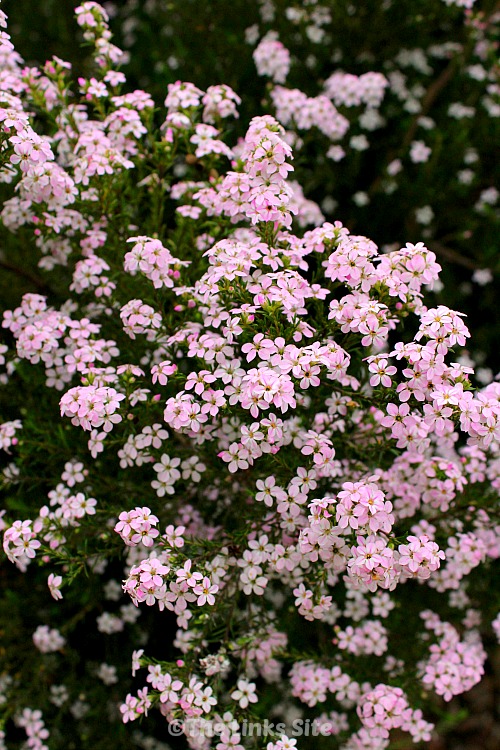
I am surprised that the diosma plant is not used more often because it is an evergreen shrub that provides colour and texture to the garden all year round. It also provides a gorgeous display of small white or pink flowers in spring. In particular the golden diosma (Coleonema Pulchrum Aurea) provides wonderful colour all year round with its yellow/green foliage.

One tip that I want to share is that older diosma plants that look like they are starting to fade can be revived with a severe pruning. After the recent drought some of the diosma plants in my garden were looking very poor. Many of the branches were dying back and they looked as if they would soon die and need replacing. I decided that if they were going to die anyway I would try and revive them by cutting them back hard and hope for new growth to appear. I cut them back so hard that they actually looked just like a clump of sticks for some time!
I did this in autumn and was pleasantly surprised that by spring they were sprouting lots of new growth and they have just continued to thrive since then. That was a couple of years ago now and I am pleased to say that the diosma, while shorter than before, are almost as bushy as they were before the drought.
There is not a lot of information available online about diosma plants but the following links provide some basic information including propagation from semi-hardwood cuttings:
Burke’s Backyard website: Diosma fact sheet
Gardening Tips ‘n Ideas website: Growing Diosma/Golden and Pink
Diosmas are such lovely plants that are very easy to care for while still providing colour and texture to the garden. I hope when you are buying new plants for your garden that you consider getting a diosma plant.
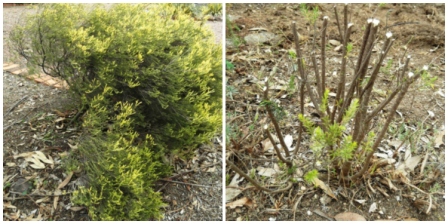
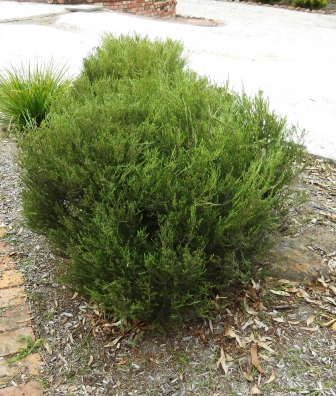
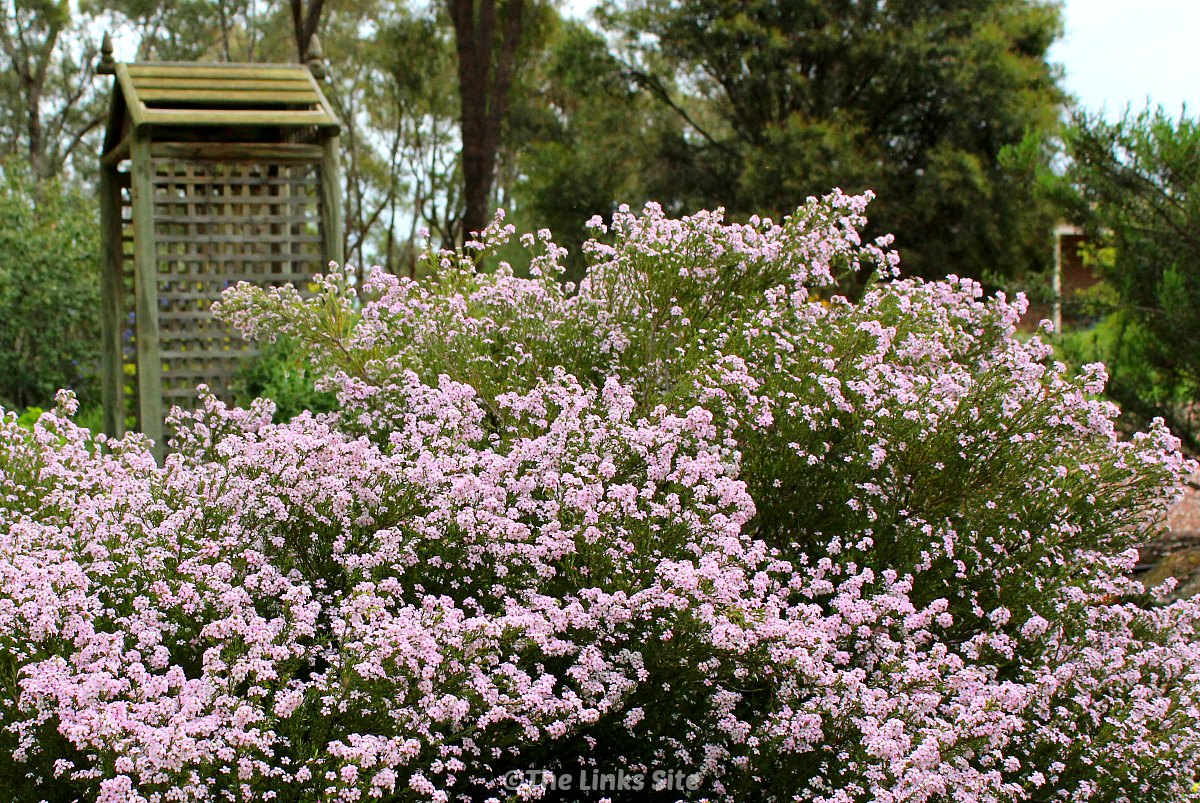

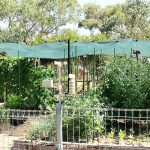


Thank you for this post about hard pruning diosma. Efficiently expressed, really first rate. It’s just the encouragement I need to try a (very) hard prune on an old, oversized diosma. If I lose it, I lose it. But I will enjoy trying to rejuvenate it nevertheless.
If your diosma is not looking to good anymore you probably don’t have anything to lose in having a go at pruning it back Kevin. Most of the ones in my garden have come back better than ever after a prune. Definitely worth a try!
Kaylene, my hard pruning of a big, old, green diosma has worked well. I am very pleased with the result. Thanks again for the inspiration.
Glad to hear that it was a success Kevin!
Thanks for the very informative post.
You’re welcome Heather!
Coincidentally, I have just hard pruned a diosma Sunset Gold. I have done this before without any problems so fully expect by mid spring it will be sprouting new growth
Hi Chris, I haven’t had to hard prune mine very often – just a tidy up is all mine normally require. But it is great to know that they bounce back well from a hard prune when they do need one!
Can you strike them
I have never tried growing them from cuttings Lorraine but I believe that you can. From what I’ve read you need to take a semi-hardwood cutting in spring or Autumn. I hope you’re successful!
I have just bought one for my uk garden, the soil is very chalky. So the question are can it live in the alkaline soil, or should I put it in a tub. In the ground what size will it grow, and ditto a tub. Thanks so much for your help.
Hi Wendy, from what I understand the diosma is pretty tolerant of most soil types (and pH) so it should be able to cope with your chalky soil. Planted in the ground it should reach about 1 meter wide and around 1 meter high after a few years. You can keep them a bit smaller by giving them a light prune ever year if you wish. I’m not sure how big that they would grow in a tub, I would imagine it depends on the size. I’ve never grown one in a pot!
They’re pretty hardy plants, we’ve got horrible clay and rocky soil but they don’t seem to mind! I’m sure it would be fine for you to plant it in your garden! I hope this helps and that the diosma does well in your garden!
Hi Kaylene
I am so glad I stumbled onto this site as I have 3 large Diosma’s in my front garden and was thinking of taking them out as they are too large and really not flowering very well anymore. I was not aware that I could cut them right back so to read your comments here is very reassuring. I live in WA, Australia and these plants really thrive, too much so as it appears. You have just saved their lives so thank you for this info. I will make sure I lightly prune them regularly when they grow back.
Hi Pam, I’m glad you found my site too! It would be a shame if you pulled them out when all they needed was a good hard prune. They’re so easy to look after and I love their little pink flowers! Ours seem to bounce back well after a good prune when they start to look a bit tired. I hope yours do too!
Hi Kaylene, the Diosmas in my garden are looking very sad after a harsh dry summer while we were away… thanks for the post, I will have to give them a hard prune. Just wondering, how are your pruned ones doing now? Have they reached their pre-prune height and width? How fast did they grow? Thanks
Hi Jim, it’s a while since I last gave one of my diosmas a hard prune but from memory mine took a couple of years to get to about half of their pre-pruned size (they were over a metre wide and high prior to pruning). It probably took another year or two for them to grow back to their original size. In general they seem to sprout again fairly quickly but it might take 3 or 4 years before they get back to their former size. Mine are still looking good several years after their last hard prune!
great post! im glad the hard prune worked out! I have two diosmas in my front garden, around 20 years old. They are healthy with tons of flowers, however they have grown halfway over the footpath. I need to prune them but i would totally reveal the brown inside, as the inside doesn’t get any light because they are so big and bushy. there is around 60cm of green then brown back to the base of the branch. im glad to see they arent like conifers and can grow from old wood, however id need to cut all the green off to bring it off the footpath but i dont really want to prune them all they way back to what it was like at year 1, do you think it would grow new shoots off the branches if i just cut the green off or do i have to say goodbye to my diosmas size with the renewal prune? i wish i could keep them the way they are but people need to walk on the footpath.
Hi Matthew, I can’t say exactly how your diosmas would go if you just cut back the green growth. You might get some new shoots on the branches if they’re still nice and healthy. When I cut back our diosmas I usually give them are hard prune because they are starting to die back anyway. I usually cut them back to around 30cm (1 foot) branches. Many of our diosmas are 15 -20 years old and most of them have experienced some browning and die back over the years. You have done a good job to have yours growing for 20 years without them browning off a bit.
Regardless of whether you cut them back hard or just prune off the green growth they will probably look a bit ordinary for a while. I’ve found that ours soon bounce back after a hard prune. Within 2 or 3 years they were almost back to their pre-pruned size. I hope you have success with your pruning!
Hello. I have a small diosmas that had a lot of commercial trimming before I bought it and planted it. It was planted in late June, in Southern California, near San Diego, ( the weather here is temperate to hot. )
I’m concerned because the plant, although alive, with the appearance of being established, it growing slightly yellow, all over.
Any suggestions?
Thanks.
Hi Sandra, could your plant be a ‘golden diosma’? I have several golden diosmas in my garden and they naturally have a yellow appearance to the foliage and produce pale pink flowers in spring. Otherwise I’m not sure why your diosma would be yellowing. Whenever there is a problem with a diosma in our garden the first sign is when a branch or two dies off and goes brown! Hopefully it’s just that you have a golden diosma so you can enjoy the yellow colour!
We had these planted in July and one looks dead and another on the other side of put yard going the same way. They are watered so don’t believe that’s an issue and they get plenty of Sun.
That’s a shame Cindy. Not sure what is happening to yours, they are generally fairly hardy. Could you be overwatering them? Ours don’t get a lot of water, once or twice a week on a drip system when it is very hot and dry.
Thank you for you quick reply! I’m newly learning about the dioramas, starting with the single one I have.
I have learned that it is a Diosma Pulchum.
Its a small plant, the product of significant pruning. The plant is airy, not tightly packed with limbs.
The weather has been at or over 100 F for months. It is watered by low pressure soaker hose. It is part of a smallish planting of lantana, bacopa and Sun drops.
The flowering plants are doing well, despite the terrible heat, but I wasn’t sure about the diosma.
I’ve looked at several online images, and most of the dioramas have a bit of yellow in their green.
Hi Diosma lovers,
Has anyone had problems with established diosmas planted near house affecting foundations?
Pam.
Hi Pamela, I don’t have any that are close to my house but I’ve got some growing very close to garden retaining walls and they don’t cause any problems. Hopefully others can add their experiences here too!
Hi Kaylene, I have 4 plants in pots that I didn’t get around to putting in the garden when the weather was warmer. Do you think it is too late to plant them now that it’s almost July? I’m next door to Armidale NSW, so we get those sub zero temperatures as well. I’m wanting to put them in a north facing position, so they will get plenty of winter sun.
Hi Celina, I think that diosmas can be a bit frost tender until they get established. If you get some sub zero temperatures you might be best to hold off planting them until spring. Plant them out as soon as you think the frosts have passed so that they can settle in a bit before the heat of summer. If you did want to plant them out sooner you would have to cover/protect them from the frost for their first winter.
Nice read! Pruning tip will certainly be handy!
We were surprised how sturdy these were in the sandy soils of Perth for 10 years (..and counting – limited by sale of the house!) Now I am in Geelong where I can swim in the clay, and am surprised how sturdy it is. Trying to manage a large area with Myoporum ground cover, I landed with proliferous wire grass weed intertwined with the ground cover. Area with Diosma and good mulch has been much easier to manage!
Thank you for the post!
You’re welcome Venky.
I’m based near Bendigo and we have awful gravel and clay soil but the diosmas seem to be able to cope! If they start to look a bit tatty I just give them a hard prune and they seem to spring back.
Hi Kaylene
I wonder if it is wise to try a hard prune now, in early October, on a rangy diosma that that has been lacking in care and attention?
Hi Louise, based on your email address I’m assuming your in Australia like me. So you probably could give it a hard prune now before the weather heats up to much. I’m in central victoria so we have a few weeks before the really hot weather sets in. I find that the ideal time to do a hard prune is autumn but I have done it at other times of the year depending on how poorly the diosma looks. If you feel the plant is in a very bad condition and might die over summer anyway then I would prune it back now. I actually did a hard prune on a couple of ours during summer (earlier this year) because they looked like they might die anyway. They had lots of die-back and looked like they were on their last legs. I checked them today and most have reshot over winter. They will probably take till next spring before they look very attractive but at least they are putting on fresh growth now! I hope this helps!
I live in the riverland and my very old row of diosmos are looking scraggly and a bit yellow .Is it ok to prune them in feb.or should I wait till it is cooler ?
Hi Karin, I would probably wait a bit longer until the worst of the summer heat is over. I’ve had the best results pruning mine back in either Autumn or early spring.
Hi Karin, a lovely lady I’m doing some gardening for has a Disoma in her front garden bed against the house (mostly shaded) that has grown out of control! She’s based NOR in Perth. Whilst the part of the plant that gets sun has beautiful green growth, the underside of the plant is basically brown dead branches. Following what you have done, should a very hard cutback bring some life back into it? Thanks for the advice on this feed – fantastic!!
Hi Moya, it sounds like a good hard prune would be good for your friends diosma. All of mine grow in full sun but even then they sometimes end up with a patch of dead growth. I cut mine right down when they start to look like that. You can cut them down to around 6 to 12 inches from the ground and they should reshoot. I try to avoid pruning mine in really hot or really cold weather (autumn and spring are great), or at least try to pick a time when you have a few milder days. I hope that helps!